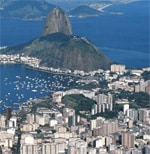COUNTRY REPORT / BRAZIL
 |
|
Buffeted by the shockwaves from the US subprime mortgage crisis, Brazil has to steer a steady course if it is to keep its economic development on track. |
When President Luiz Inácio Lula da Silva, a proclaimed leftist, first took power in 2003, many predicted a “meltdown” of the Brazilian economy. Instead, Lula turned out to be what some describe as a “model of fiscal discipline,” embracing economic policies favored by the markets and foreign investors. Benchmark interest rates may still be high and business bureaucracy and taxation stifling, but major economic indicators such as the current account balance and inflation are encouraging.
“Brazil is in good shape with a current account surplus, no debt denominated in US dollars and more than $150 billion in FX reserves,” observes Alexander Kazan, a Latin America equity analyst at Bear Stearns in New York. The Brazilian economy has gone from sustaining a current account deficit of 4.6% of GDP in 2001 to a surplus of 1.33% of GDP in 2007.
High interest rates have helped reduce price inflation from double-digit figures in Lula’s first term to an average of 3.3% in 2007. Compound annual growth rates in portfolio flows have also been encouraging, with flows in the 12 months through June 2007 totaling $34.9 billion, with $4.8 billion in June 2007 alone, note analysts at Bear Stearns. Foreign investment is also at its highest levels since Brazil’s major privatization wave from 1998 to 2000. “After several years of trending lower, gross FDI into Brazil has increased notably throughout 2007,” the Bear Stearns analysts write. In the past three months FDI in Brazil has averaged $5.3 billion, dramatically higher than the $686 million recorded during the same period a year ago.
“Brazil’s economy has evolved so dramatically in the last few years,” observes Otaviano Canuto, vice president of the Inter-American Development Bank (IDB), which has been active in the country since 1998. “That has meant that Brazil does not need us so much for disbursements. It can finance itself in the international capital markets,” he adds.
Brazil’s current account surplus has seen the Brazilian real appreciate. Since Lula first took office, the real has appreciated almost 40% against the US dollar, although it slipped around 10% during the market turmoil this August. Brazil’s Bovespa stock index also sold off during the subprime crisis, but since Lula first took office it has been on an upward trajectory, with a significant pipeline of IPOs fueling foreign investors’ appetite for exposure to Brazilian equities.
In addition to foreign investment, local institutional investors are also playing an important role in strengthening Brazil‘s economy. Canuto says development of the local capital markets has been boosted by growth in personal savings levels and pension funds seeking local investment opportunities.
Brazil’s stronger economic fundamentals put it in a better position to weather any decline in global financial market conditions, including the recent US subprime mortgage crisis. “Although we have seen some currency volatility and falls in equity prices, if you compare it with previous periods of global uncertainty—the Argentina debt crisis, for example, and the Asian crisis—we are not seeing the kind of volatility we saw back then,” says Kazan. “It is much more moderated, which reflects the maturation of the economic fundamentals in these countries, particularly Brazil.”
Thomas Trebat, executive director of the Institute of Latin American Studies at Columbia University, says recent events in the United States could lead to “considerable financial volatility” in the near term. “As much as the Latin economies have done to build in shock absorbers over the last 10 years, it is important not to underestimate the short-term risks to the Latin American markets as investors flee risk globally,” Trebat wrote on the Latin America Economonitor website. “Countries such as Brazil and Argentina, perhaps for a different mix of reasons, are going to see significant amounts of capital leaving as international investors sell assets in these countries to fund losses arising elsewhere in global portfolios.”
Trebat believes Brazil is especially vulnerable because it has received so much international investment. Others, though, say any impact from the US market’s credit woes is likely to be more indirect. “There is no direct connection between the subprime crisis in the US and Brazil,” says Kazan. “Many Brazilian banks have zero or little exposure to the crisis and are not holding these instruments, and the credit quality of banks, insurance companies and financial systems in most of Latin America is strong.”
Canuto points to Brazil’s diversified trade base, which he says means it is not wholly reliant on US growth. “As long as Asian growth remains robust, it may compensate for any slowdown in Western economies,” he says. Indeed, high commodity prices boosted by industrial demand from countries such as China have contributed significantly to Brazil’s current account surplus.
The China Factor
Analysts are waiting to see if a slowdown in the US has a severe impact on Asian industrial demand for Brazilian exports such as iron ore, steel, materials and machinery. Commodity exports comprise approximately 50% of Brazil’s total exports, and China accounts for 7% of Brazil’s total exports, up from 3% of total exports in 2002, with year-on-year growth in exports to China exceeding that to the rest of the world.
 |
|
Alexander Kazan, Bear Stearns: There is no direct connection between the subprime crisis in the US and Brazil. |
According to Bear Stearns, Chinese officials are looking to reduce the levels of fixed-asset investment (FAI) growth, and the possibility of further interest rate hikes in China cannot be ruled out. The upshot of all this is that if Chinese policymakers slow investment in plant and equipment growth, Brazil’s export receipts may slow. “Going forward, the main risk is what is happening in China in terms of further monetary tightening and the impact Chinese demand has had on prices of commodities,” says Kazan.
GDP levels in Brazil remain a talking point among international observers. Although Brazil is in a fundamentally stronger economic position than ever before, its growth rate continues to disappoint. According to the US-based Brazil Institute at the Woodrow Wilson Center, Brazil has grown at a “sluggish” average of 2.6% for the past four years. High levels of domestic demand, lower inflation and real interest rates, and investment and income growth should help Brazil’s annual average GDP growth accelerate over the next few years, though.
While Lula’s second term has not seen as aggressive a reform agenda as some would have liked, in an effort to boost the growth rate to 5% Lula in January unveiled his Growth Acceleration Program (Programa de Aceleração do Crescimento, or PAC), which is to be implemented between 2007 and 2010. PAC aims to accelerate growth through increased public investment totaling $236 billion in infrastructure and social programs including oil and gas, electrical energy, sanitation, habitation and railroads.
PAC also includes measures to stimulate private investment and remove “bureaucratic, legal, judicial and legislative barriers to growth.” Observers say PAC is targeting the right areas, although some skepticism remains regarding its execution. The IDB, which hopes to play a role in the PAC initiative, says it does not share these concerns. Responding to suggestions that second-term Lula is suffering from “reform fatigue,” Canuto says the current regime is trying to strike a balance between investment and fiscal restraint.
Lula is also starting to tackle the country’s unwieldy corporate tax regime, although Kazan says that any slated reforms are unlikely to lower the overall tax burden, which is the most important structural problem in Brazil. Another concern is Brazil’s current public debt/spending ratio, which at 50% is considered to be too high, when most emerging markets maintain a ratio of less than 30%. Paulo Levy of the Institute of Applied Economic Research in Rio de Janeiro speculates that Brazil’s high public debt has prevented it from receiving investment-grade status. However, last year Standard & Poor’s upgraded its rating of Brazil’s foreign currency sovereign debt from BB- to BB, two notches below investment-grade status. Canuto remains optimistic. “As long as GDP remains close to 4%, public debt will climb below 40% before the end of the decade,” he predicts.
Anita Hawser



